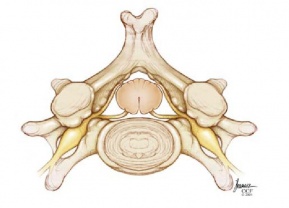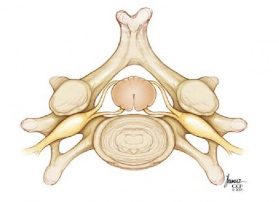Cervical Stenosis
Original Editors
Lead Editors - Your name will be added here if you are a lead editor on this page. Read more.
Search Strategy[edit | edit source]
Databases searched: Pubmed, Pedro, Science Direct,…
Keywords searched: Cervical Stenosis, Physical Therapy, Spinal Stenosis, Treatment, Stenosis, Neck, …
- Most successfull keywords are Cervical Stenosis and Spinal Stenosis
- Most succesfull combinations are Cervical Stenosis AND Treatment AND Physical Therapy
Definition/Description[edit | edit source]
The changes that occur to the vertebrae is that the spinal canals of these vertebrae are narrowing, and that this narrowing may result in a pinch of the spinal cord and/or the nerve roots. Because of this, the function of the spinal cord or the nerve may be affected, which may cause symptoms like cervical radiculopathy or cervical myelopathy.
Clinically Relevant Anatomy[edit | edit source]
The cervical vertebrae are the smallest vertebrae if they are compared with the other spinal vertebrae. There purpose is to contain and protect the spinal cord, support the skull and enable diverse head movements.
The ligaments are not only used to prevent excessive movements, which may lead to serious injuries but most specifically to guide the intra-articular movements in the mostoptimal directions among others avoiding cartilage damage and muscle hypertonicity.
There are muscles that help the cervical spine to maintain its balance and stability for example:
- Longus capitis
- Longus colli
- Spinalis cervicis
- Spinalis capitis
- ...
But there are also muscles that ensures that the head can move for example:
- Sternocleidomastoid
- Scalenus anterior
- Scalenus medius
- Scalenus posterior
- ...
Epidemiology /Etiology[edit | edit source]
Cervical stenosis may occur at a very slow or fast rate. The changes that occur to the vertebrae is that the spinal canals of these vertebrae are narrowing, and that this narrowing may result in a pinch of the spinal cord and/or the nerve roots. Because of this, the function of the spinal cord or the nerve may be affected, which may cause symptoms like cervical radiculopathy or cervical myelopathy. Cite error: Invalid <ref> tag; name cannot be a simple integer. Use a descriptive title
Normal cervical vertebrae Cervical vertebrae with cervical stenosis
Characteristics/Clinical Presentation[edit | edit source]
Cervical stenosis does not necessarily cause symptoms, but if symptoms are present they will mainly be caused by cervical radiculopathy or cervical myelopathy.
The symptoms are:Cite error: Invalid <ref> tag; name cannot be a simple integer. Use a descriptive titleCite error: Invalid <ref> tag; name cannot be a simple integer. Use a descriptive titleCite error: Invalid <ref> tag; name cannot be a simple integer. Use a descriptive title
- Pain in neck or arms
- Arm and leg dysfunction
- Weakness, stiffness or clumsiness in the hands
- Leg weakness
- Difficulty walking
- Frequent falling
- The need to use a cane or walker
- Urinary urgency which may result in later cases in bladder and bowel incontinence
- Diminished proprioception
The progression of the symptoms may also vary:
- A slow and steady decline
- Progression to a certain point and stabilizing
- Rapidly declining
Differential Diagnosis[edit | edit source]
add text here
Diagnostic Procedures[edit | edit source]
Physical examination: Cite error: Invalid <ref> tag; name cannot be a simple integer. Use a descriptive titleCite error: Invalid <ref> tag; name cannot be a simple integer. Use a descriptive titleCite error: Invalid <ref> tag; name cannot be a simple integer. Use a descriptive titleCite error: Invalid <ref> tag; name cannot be a simple integer. Use a descriptive title
- Increased reflexes in the knee and ankle, this is called a hyperreflexia, it’s sometimes found with depressed reflexes in the arm
- Changes in the gait such as clumsiness or loss of balance
- Loss of sensitivity in the hand/or feet
- Rapid foot beating that is triggered by turning the ankle upward.
- Babinski’s sign
- Hoffman’s sign
X- rays of the cervical spine doesn’t provide enough information to confirm cervical stenosis, but can be used to rule out other conditions. Cervical stenosis can occur at one level or multiple levels of the spine, therefore is an MRI useful for looking at several levels at one time. It’s also useful to use MRI images because they are very detailed and show the tight spinal canal and pinching of the spinal cord. But a CT scan can give better information about the bony invasion of the canal and can be combined with myelography. Cite error: Invalid <ref> tag; name cannot be a simple integer. Use a descriptive titleCite error: Invalid <ref> tag; name cannot be a simple integer. Use a descriptive title
Outcome Measures[edit | edit source]
add links to outcome measures here (also see Outcome Measures Database)
Examination[edit | edit source]
add text here related to physical examination and assessment
Medical Management
[edit | edit source]
In cases with increasing weakness, pain or instability to walk, then is surgical management ofcervical spine stenosis[1]recommended. Cite error: Invalid <ref> tag; name cannot be a simple integer. Use a descriptive titleCite error: Invalid <ref> tag; name cannot be a simple integer. Use a descriptive title
Surgical options include anterior decompression and fusion, where the disc and bone material are causing spinal cord compression is removed from the front and the spine is stabilized. The stabilizing
of the spine, which is called fusion, places an implant between the two cervical segments to support the spine and compensate for the bone and the disc that has been removed. Cite error: Invalid <ref> tag; name cannot be a simple integer. Use a descriptive titleCite error: Invalid <ref> tag; name cannot be a simple integer. Use a descriptive titleCite error: Invalid <ref> tag; name cannot be a simple integer. Use a descriptive titleCite error: Invalid <ref> tag; name cannot be a simple integer. Use a descriptive titleCite error: Invalid <ref> tag; name cannot be a simple integer. Use a descriptive titleCite error: Invalid <ref> tag; name cannot be a simple integer. Use a descriptive title
Another surgical option is laminectomy. This is a procedure where the bone and ligaments that are pressing against the spinal cord are being removed. In this treatment the surgeon might add also a fusion to stabilize the spine. Cite error: Invalid <ref> tag; name cannot be a simple integer. Use a descriptive titleCite error: Invalid <ref> tag; name cannot be a simple integer. Use a descriptive titleCite error: Invalid <ref> tag; name cannot be a simple integer. Use a descriptive titleCite error: Invalid <ref> tag; name cannot be a simple integer. Use a descriptive titleCite error: Invalid <ref> tag; name cannot be a simple integer. Use a descriptive titleCite error: Invalid <ref> tag; name cannot be a simple integer. Use a descriptive title
After the surgery, the patient has to remain in the hospital for several days. A postoperative rehabilitation program may be given, so that the patient can return to his activities and his normal life.
Physical Therapy Management
[edit | edit source]
Nonoperative treatments, such as physical therapy management, are aimed at reducing pain and increasing the function. Nonoperative treatments do not change the narrowing of the spinal canal, but it can provide the patient of a long-lasting pain control and improved life function without surgery. A rehabilitation program may require 3 or more months of supervised treatment. Cite error: Invalid <ref> tag; name cannot be a simple integer. Use a descriptive title
A physical therapy or exercise program consists of the following exercises: Cite error: Invalid <ref> tag; name cannot be a simple integer. Use a descriptive titleCite error: Invalid <ref> tag; name cannot be a simple integer. Use a descriptive title (Level of evidence 2A, Grade of Evidence B)
- Stretching exercises, these exercises are restoring the flexibility of the muscles of the neck, trunk, arms and legs.
- Cardiovascular exercises for arms and legs, this will improve the blood circulation of the patient and will also train the endurance.
- Specific strengthening exercises for the arm, trunk and leg muscles.
- Training of activity of daily living (ADL).
There also exists a postoperative rehabilitation program for patients who underwent a surgical intervention.
Key Research[edit | edit source]
add links and reviews of high quality evidence here (case studies should be added on new pages using the case study template)
Resources
[edit | edit source]
add appropriate resources here
Clinical Bottom Line[edit | edit source]
add text here
Recent Related Research (from Pubmed)[edit | edit source]
see tutorial on Adding PubMed Feed
Extension:RSS -- Error: Not a valid URL: Feed goes here!!|charset=UTF-8|short|max=10
References[edit | edit source]
see adding references tutorial.








